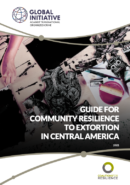In the heart of Central America, communities in Guatemala, El Salvador and Honduras face a persistent challenge: extortion. This scourge, fuelled by violence and instability, affects not just individuals, but also the entire social fabric of communities. Besides imposing an economic cost, extortion threatens the emotional and social stability of its victims.
Recognizing the different types of extortion is the first step in fighting it effectively and protecting our communities.
This manual explores the various faces of extortion, from the most traditional forms to the most sophisticated tactics employed by criminals. Through concrete examples and detailed analyses, this manual provides an overview of how extortion manifests in different contexts, and what the government, nongovernmental organizations (NGOs), the business sector and communities are doing to address this social problem.
This manual is divided into six modules, with the goal of clearly and accessibly explaining the impact of extortion at the community level, as well as strategies to address it. These modules are:
- MODULE 1: What is extortion?
- MODULE 2: What is the impact of extortion at the local level?
- MODULE 3: How can extortion be addressed?
- MODULE 4: What should I do if someone tries to extort me?
- MODULE 5: How can community action be turned into an initiative against extortion?
- MODULE 6: How can the community monitor and provide support to victims of extortion?
This manual was first published in 2021. This new version updates focus areas and responses by different sectors to address extortion. It is intended to be a vital tool for communities so they can show a unified front against extortion.
This document has been updated thanks to the generous support of the people of the United States through USAID. The content of this document is the responsibility of the Global Initiative Against Transnational Organized Crime, and does not necessarily reflect the viewpoint of USAID or the United States government.
En el corazón de Centroamérica, las comunidades de Guatemala, El Salvador y Honduras enfrentan un desafío persistente: la extorsión. Este flagelo, alimentado por la violencia y la inseguridad, afecta no solo a individuos, sino también al tejido social de las comunidades. Además de imponer un costo económico, la extorsión amenaza la estabilidad emocional y social de quienes la sufren.
Reconocer las distintas modalidades de extorsión es el primer paso para combatirla de manera efectiva y proteger a nuestras comunidades.
Este manual explora las diversas caras de la extorsión, desde las formas más tradicionales hasta las tácticas más sofisticadas empleadas por los delincuentes. A través de ejemplos concretos y análisis detallados, se ofrece una visión panorámica de cómo la extorsión se manifiesta en diferentes contextos y lo que están haciendo el Estado, la sociedad civil, el sector empresarial y las comunidades para enfrentar esta problemática social.
Los seis módulos tienen el propósito de explicar de manera clara y accesible el impacto de la extorsión a nivel comunitario, así como las estrategias para hacerle frente. Estos módulos son:
- MÓDULO 1: ¿Qué es la extorsión?
- MÓDULO 2: ¿Qué impacto tiene la extorsión a nivel local?
- MÓDULO 3: ¿Qué respuestas se dan ante la extorsión?
- MÓDULO 4: ¿Qué hacer frente a un caso de extorsión?
- MÓDULO 5: ¿Cómo se convierte la acción comunitaria en una iniciativa contra la extorsión?
- MÓDULO 6: ¿Cómo brindar apoyo y acompañamiento comunitario a las víctimas de extorsión?
Este manual fue publicado por primera vez en el 2021. Esta nueva versión constituye un esfuerzo por actualizar los enfoques y las respuestas que se dan por los distintos sectores para abordar la extorsión. Por ello, pretende ser una herramienta vital para las comunidades que buscan fortalecerse frente a la extorsión.
Este documento fue posible gracias al apoyo generoso del pueblo de los Estados Unidos, a través de USAID. El contenido de este documento es responsabilidad de Global Initiative Against Transnational Organized Crime, y no necesariamente refleja el punto de vista de USAID o del Gobierno de los Estados Unidos.



